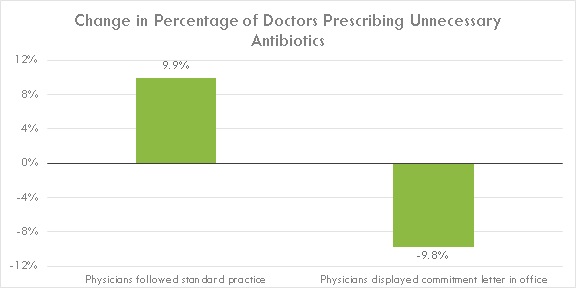
Pledges Curb Antibiotic Over-Prescription
Organization : Center for Health Incentives and Behavioral Economics
Project Overview
Project Summary
Clinicians signed poster-sized letters stating their commitment to avoid unnecessary antibiotic prescribing and displayed them in their examination rooms.
Impact
Clinicians who signed and displayed commitment letters reduced their antibiotic prescription rates 9.8 percentage points, from 43.5% to 33.7%.
Source
Source
Challenge
By some estimates, half the 41.2 million antibiotic prescriptions issued annually in the United States are inappropriately prescribed to treat respiratory infections for which antibiotics have not been shown to provide any relief. Common reasons for the over-prescription of antibiotics, which include “defensive prescribing,” physicians’ lack of awareness of diagnostic guidelines and patient demand, are not considered adequate justification for revising prescription guidelines. This study explored the viability of a behavioral “nudge” in lieu of revised prescription guidelines.
Design
A group of clinicians wrote letters stating their commitment to prescribe antibiotics only when necessary; they also explained why the medication is often unwarranted. The clinicians then displayed an 18×24 inch copy of the commitment letters, which featured their photo and signature, in their own examination rooms for 12 weeks. The letters were written at an eighth grade reading level and were posted in both English and Spanish.
Text from letters displayed in examination rooms
“We want to give you some important information about antibiotics.
Antibiotics, like penicillin, fight infections due to bacteria that can cause some serious illnesses. But these medicines can cause side effects like skin rashes, diarrhea, or yeast infections. If your symptoms are from a virus and not from bacteria, you won’t get better with an antibiotic, and you could still get these bad side effects.
Antibiotics also make bacteria more resistant to them. This can make future infections harder to treat. This means that antibiotics might not work when you really need them. Because of this, it is important that you only use an antibiotic when it is necessary to treat your illness.
How can you help? Carefully follow your doctor’s instructions. He or she will tell you if you should or should not take antibiotics.
When you have a cough, sore throat, or other illness, your doctor will help you select the best possible treatments. If an antibiotic would do more harm than good, your doctor will explain this to you, and may offer other treatments that are better for you.
Your health is very important to us. As your doctors, we promise to treat your illness in the best way possible. We are also dedicated to avoid prescribing antibiotics when they are likely to do more harm than good.
If you have any questions, please feel free to ask your doctor, nurse, or pharmacist.”
Impact

This randomized evaluation found that simply signing and displaying a commitment letter in an examination room reduced inappropriate antibiotic prescribing rates by 19.7 percentage points when compared to clinicians following standard practice. Physicians who made the public commitment decreased their rate of prescribing inappropriate antibiotics by 9.8 percentage points in the first 12 weeks after signing and displaying their letter, from 43.5% to 33.7%. On the other hand, those in the control group showed an increase in unnecessary antibiotic prescriptions, raising their rates 9.9 percentage points, from 42.8% to 52.7%.
If scaled nationally, posting commitment letters could cut 2.6 million inappropriate antibiotic prescriptions and over $70 million in costs.
Implementation Guidelines
Inspired to implement this design in your own work? Here are some things to think about before you get started:
- Are the behavioral drivers to the problem you are trying to solve similar to the ones described in the challenge section of this project?
- Is it feasible to adapt the design to address your problem?
- Could there be structural barriers at play that might keep the design from having the desired effect?
- Finally, we encourage you to make sure you monitor, test and take steps to iterate on designs often when either adapting them to a new context or scaling up to make sure they’re effective.
Additionally, consider the following insights from the design’s researcher:
- The letters should be simple and avoid using complex jargon.
- Letters should be written in multiple languages depending on the population.
- Make sure the letter is large enough to read from a distance (e.g. a poster) and displayed in a spot that is easily visible for both the clinician and the patient.
Project Credits
Researchers:
Daniella Meeker Contact RAND Corporation
Tara K. Knight University of Southern California
Mark W. Friedberg Harvard Medical School; RAND Corporation; Brigham and Women’s Hospital
Jeffrey A. Linder Harvard Medical School; Brigham and Women’s Hospital
Noah J. Goldstein University of California, Los Angeles
Craig R. Fox University of California, Los Angeles
Alan Rothfeld COPE Health Solutions
Guillermo Diaz QueensCare Family Clinics
Jason N. Doctor University of Southern California


